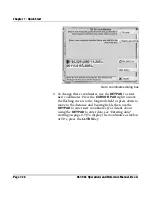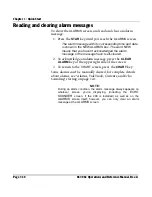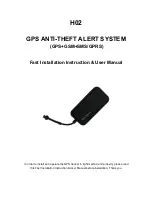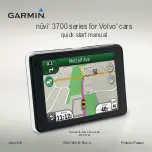
Chapter 1 - Quick Start
961/962 Operations and Reference Manual, Rev. A
Page 1-15
Highlight One: Basic navigation terms
Bearing:
The true or magnetic course from your
present position to a waypoint
.
Coordinates:
Coordinates specify a position on the
earth’s surface using latitude and longitude (see
this table), Loran-C TDs, or distance and bearing
from a fixed location. (The term Loran-C TDs refers
to Loran-C Time Differences; for details, see the
Glossary.)
Course-over-ground (COG):
The actual path of
your vessel in relation to the surface of the earth;
that is, the direction your vessel is actually moving.
Cross-track error (XTE):
The distance between
your position and your desired track; that is, how far
off you are from your intended course line. XTE is
displayed both numerically (as nm, mi, or km and
the equivalent ft or M) and graphically.
Desired track:
An imaginary line that the system
calculates, which represents the path that you plan
to follow, usually from one waypoint to the next. On
the
CHART
screen, the desired track is displayed
as a green line.
Global Positioning System (GPS):
Developed by
the U.S. Department of Defense, GPS is a satellite
navigation system that computes your position
using signals from a system of 24 earth-orbiting
satellites.
Latitude:
Imaginary lines on the earth’s surface
running east/west, expressed as the number of
degrees (0 to 90) north or south of the Equator.
Leg:
The line, or path, between any two waypoints
in a route or a trip.
Longitude:
Imaginary lines on the earth’s
surface running north/south, expressed as the
number of degrees (0 to 180) east or west of the
Prime Meridian, a line running from the North
Pole to the South Pole.
Nautical mile (nm):
One nm equals 6,076 feet,
compared to a statute mile, which is 5,280 feet.
A nautical mile also equals one minute of
latitude.
Position:
See Coordinates.
Route
:
A group of two or more pre-defined
waypoints that form a connected path to and/or
from specific locations. A typical route consists
of a starting waypoint, a destination waypoint,
and a series of legs connecting those
waypoints. On the
CHART
screen, a route is
displayed as a dark blue line. (If you’re
“following” a route, however, the route is copied
into the trip, so it isn’t displayed as dark blue
anymore. For details about following a route,
see “What is a route?” starting on page 8-2.)
Speed-over-ground (SOG):
The actual speed
of your vessel in relation to the surface of the
earth.
Track:
As used in 961/962 operations, a path
that you either plan to follow or have already
followed. For complete details about the track
feature, see “Introducing tracks” starting on
page 9-2.
Waypoint:
A specific position defined by its
coordinates of latitude and longitude, TDs, or
distance and bearing, and used as either an
intermediate or a final destination.
Summary of Contents for 961
Page 6: ...Page viii 961 962 Operations and Reference Manual Rev A ...
Page 8: ...Page x 961 962 Operations and Reference Manual Rev A ...
Page 14: ...Page xvi 961 962 Operations and Reference Manual Rev A ...
Page 92: ...Chapter 3 Using the Controls Page 3 34 961 962 Operations and Reference Manual Rev A ...
Page 160: ...Chapter 6 Creating Waypoints Page 6 18 961 962 Operations and Reference Manual Rev A ...
Page 176: ...Chapter 7 Creating Avoidance Points Page 7 16 961 962 Operations and Reference Manual Rev A ...
Page 202: ...Chapter 8 Creating Routes Page 8 26 961 962 Operations and Reference Manual Rev A ...
Page 380: ...Glossary Page G 8 961 962 Operations and Reference Manual Rev A ...















































